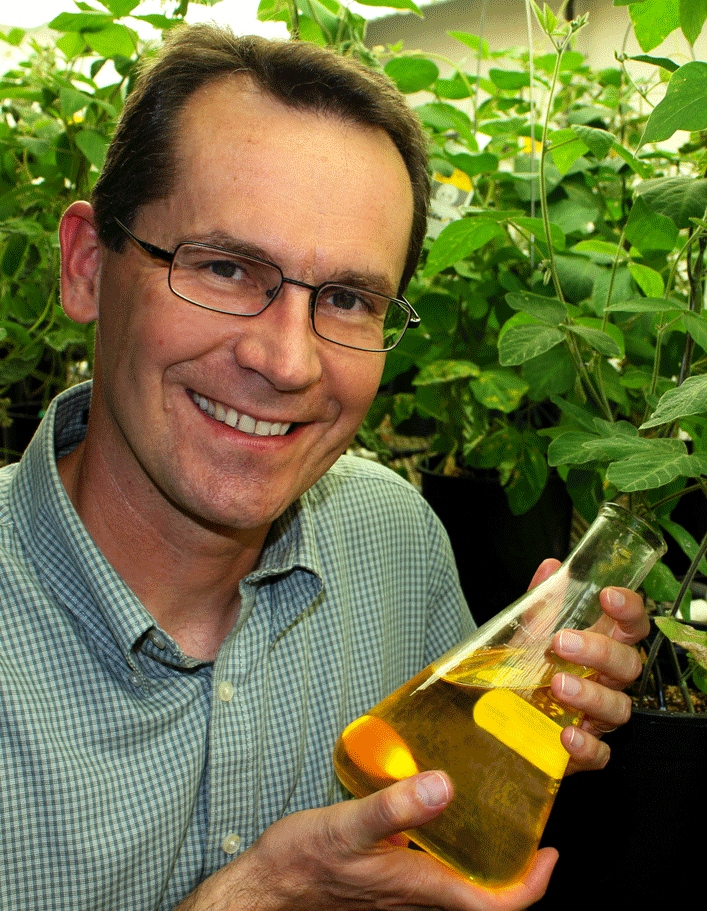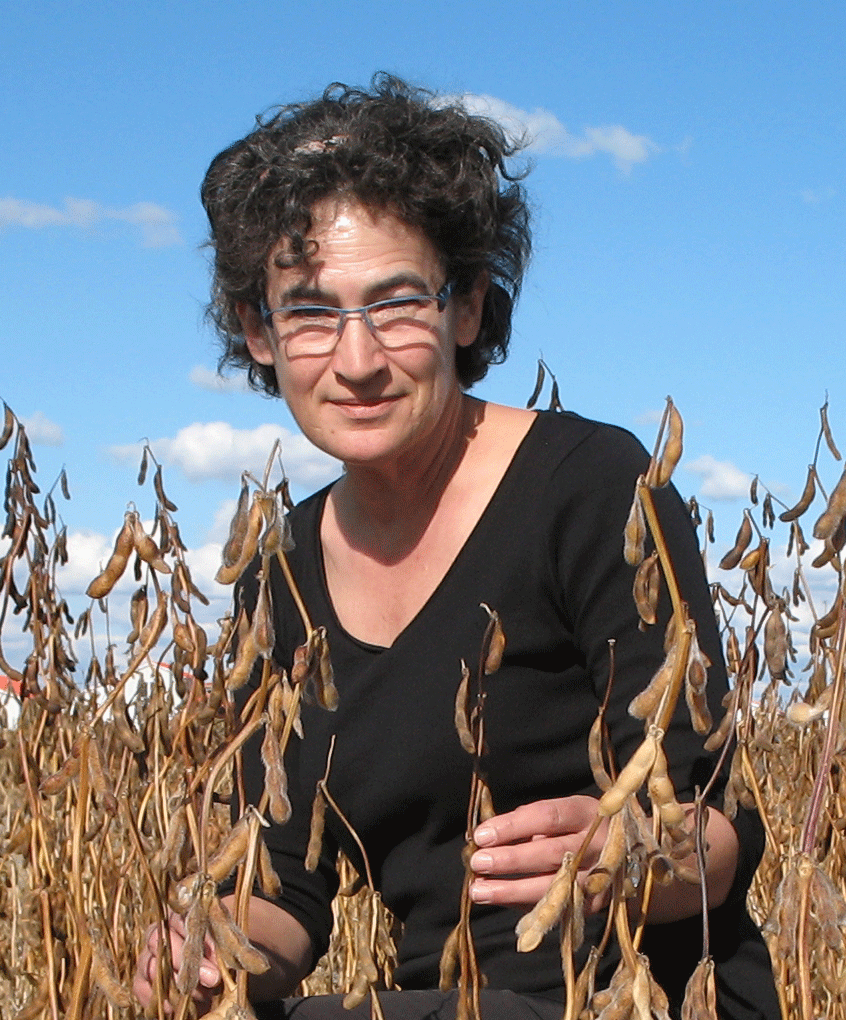Soybean genetics
HOW RESEARCHERS ARE IMPROVING BREEDING PROGRAMS
geneticists and soybean breeders are partnering across eastern Canada to gain a deeper insight into the molecular process it takes to build a better soybean, cheaper and faster than ever before.
In the last 10 years, there’s been a revolution in the capacity to sequence all genomes worldwide. Now, geneticists can bring that power into the realm of applied science, including plant breeding.
Dr. Francois Belzile is a molecular biologist and geneticist at the University of Laval who, fortunately for farmers, has a passion for plant breeding. He says today’s scientists have the technology required to sequence every single variety of soybean that’s out there but that would be tremendously time consuming and costly. Instead, he and his team have partnered with three soybean breeders in Quebec and Ontario to take a more manageable look at limited areas in the genome and study these bite-sized pieces of code.
PHOTO : DR. FRANCOIS BELZILE
 “We’re basically bringing the power of these sequencing technologies to bear fruit in the area of plant breeding,” said Belzile. “It’s like shining a flashlight on a very small portion of chromosomes and having a glimpse of different tidbits where, at each spot, we’re finding differences.”
“We’re basically bringing the power of these sequencing technologies to bear fruit in the area of plant breeding,” said Belzile. “It’s like shining a flashlight on a very small portion of chromosomes and having a glimpse of different tidbits where, at each spot, we’re finding differences.”
Using DNA extracted from just a small segment of a leaf, the genotyping by sequencing (or GBS) method yields a unique genetic fingerprint for each soybean line composed of thousands of DNA markers. Belzile and his team of researchers have been working to identify such differences in 300 different varieties, the top 100 of interest to each of the breeders and a representative collection of soybean germplasm in use in public breeding programs for the east of the country. Belzile hopes that by adapting these technologies that are already available to corn and rice breeders, soybean breeders will have a better working knowledge of parent materials and the lines that are in advanced breeding trials.
“By having a more intimate knowledge of what we have inside that plant, we’re able to better compare the performance of different mutations; and maybe we find the one that performs the best in our conditions in Canada,” said Belzile. “That’s the type of insight we’re able to get by having such a detailed genetic fingerprint of these lines.”
soybeans and their genes
Belzile says breeders know that crossing two soybean lines which are extremely similar has a fairly limited potential to develop something new. But without genetic insight, they’re not always able to know how closely related material is. Belzile soon realized the potential impact he could make simply by characterizing genetic material in detail for breeders and his complete database can now make breeders’ jobs easier in matching the best potential crosses.
“A breeder has a wide array of materials to choose from in his program and the challenge is, most of the material generated will have to go into the trash bin,” said Belzile. “We are using DNA markers to help breeders make informed decisions about what genetic makeup is the most promising, trying to identify rare combinations that outperform what is already a highly tuned machine.”
While completing the first phase of the project, Belzile even improved the technologies currently available in the industry. When he started working on the project three years ago, Belzile says molecular marker technology was capable of delivering about 1,000 DNA markers per genetic line. But in the last year and a half, Belzile’s team has been able to expand the process, achieving over 20,000 markers per line, and simultaneously reducing upfront costs from $60,000 to just $30 a variety. It’s an advancement Belzile hopes will revolutionize soybean research by making genetic analysis more accessible to everyone.
“We have way outperformed what we had planned originally and this provides a much more detailed understanding of the genetic composition,” said Belzile. “Now this new technology that we’ve participated in developing is a lot more accessible to a broad range of users.”
FIGURE: THIS FIGURE SHOWS THE RELATIONSHIPS BETWEEN THE VARIOUS LINES IN BELZILE’S RESEARCH PROGRAM. EACH COLOUR IDENTIFIES THE LINES PROVIDED BY THE THREE SOYBEAN BREEDERS.

genes in the field
It’s one thing to know what genes you’re working with, but it’s another to know how they work in the field. Belzile says there are many environmental effects that mask the potential performance of a line, so the next step is to analyze and catalogue all 300 lines through a standardized procedure that will characterize the behaviour of genes in the field.
This is where the breeding collaborators are pitching in. Each ran plot trials earlier this year that came from parent stock crosses which had been analyzed by Belzile’s new program. Dr. Istvan Rajcan, a soybean breeder at the University of Guelph, is managing the southwestern Ontario plot trials for the group. Rajcan says that although he can’t completely use the technology until they’ve finished connecting genotypic and phenotypic characteristics, he’s very excited to start working more genetic strategies into his breeding programs.
PHOTO: DR. ISTVAN RAJCAN
 “This is a major improvement in the accuracy of our selection and the breadth and width of what we can select for within the chromosomes,” said Rajcan.
“This is a major improvement in the accuracy of our selection and the breadth and width of what we can select for within the chromosomes,” said Rajcan.
In Québec, Dr. Louise O’Donoughue of le Centre de recherche sur le grains inc. (CÉROM), has already seen the impact of Belzile’s work. She’s working on early maturity varieties and is trying to find which maturity genes are the most efficient to produce good yielding early maturing lines.
O’Donoughue is using the marker technology to characterize all eight known genetic regions affecting maturity in potential parental material. She says that before they began to receive marker information from Belzile, she could only envisage analysing one region a year. With the new technology, three regions have been studied in the last year and they were able to identify two new early maturity mutations in one of these regions. Since each mutation behaves differently in order to cause earliness in soybeans, not all mutant maturity genes will be equally beneficial and some are less likely to have a detrimental effect on yield.
O’Donoughue says Belzile’s new technology is also useful in her research because it will allow her to look at what else is going on with soybean chromosomes and how these thousands of genes may work in combination with early maturity gene combinations.
PHOTO: DR. LOUISE O’DONOUGHUE

“The genotyping by sequencing has allowed us to proceed much faster than we anticipated we would,” said O’Donoughue. “I couldn’t have expected, in two years, to [analyze] more than one or perhaps two genes, so on top of shaving off years of work, it allows us to do much more as far as moving forward with targeted crosses.”
In Ottawa, Dr. Elroy Cober, a soybean breeder with Agriculture and Agri-Food Canada, works on short season and specialty type soybeans for the export and value-added markets. Like O’Donoughue, he’s using Belzile’s work right now to identify genetic differences between short season soybean germplasm. But Cober says the most important contribution Belzile has accomplished through his work is enabling the collaboration between himself and the breeders. He says the project is an excellent example of good inter-provincial cooperation and he hopes it leads to more collaboration in the future.
“We’ve worked together trading trials and parents before but we’re actually doing a bigger project than any of us could do on our own,” said Cober. “I wouldn’t have been involved in any of this advanced genomics at all on my own.”
PHOTO: DR. ELROY COBER
 The “Advancing Canadian Field Crops through Breeding” project began in April 2010 and will continue through March 2013. The project is part of a three-year $5.7 million partnership with the Canadian Field Crop Research Alliance (CFCRA) and Agriculture and Agri-Food Canada (AAFC) through the Growing Forward Developing Innovative Agri-Products (DIAP) program. Grain Farmers of Ontario is a founding member and contributor to the CFCRA, which is an alliance of provincial farm organizations and industry partners. •
The “Advancing Canadian Field Crops through Breeding” project began in April 2010 and will continue through March 2013. The project is part of a three-year $5.7 million partnership with the Canadian Field Crop Research Alliance (CFCRA) and Agriculture and Agri-Food Canada (AAFC) through the Growing Forward Developing Innovative Agri-Products (DIAP) program. Grain Farmers of Ontario is a founding member and contributor to the CFCRA, which is an alliance of provincial farm organizations and industry partners. •






















